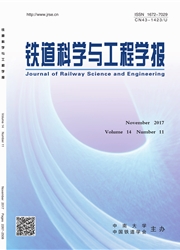

 中文摘要:
中文摘要:
基于RealizableA-s方程的DES数值模拟方法,研究某高速列车头、中和尾车不同区域对整车气动阻力系数的贡献值,并结合风洞试验结果,验证苓文所采用的计算方法,计算与风洞试验结果两者偏差在2%以内;各车辆的瞬态气动阻力系数时程曲线在均方根值上下波动,其中头车的脉动幅度最小,尾车最大;头车、尾车的头部曲面区域及各个车辆转向架区域的气动阻力占整车气动阻力的77.8%;前端转向架区域气动阻力系数从头车、到中间车、到尾车大幅度减少,后端转向架区域气动阻力系数逐渐增加;从流场结构来看,列车的头部、风挡、车底结构以及车尾处产生了大量的漩涡;沿车长方向,头车车体附近的漩涡情况好于中车和尾车。
 英文摘要:
英文摘要:
The paper studies the contribution value of head,middle and tail regions of a high -speed train for aerodynamic drag coefficient of the whole train using DES method based on Realizable k-εequation.Combined with the results of wind tunnel test to verify the methods used in this paper,it can be found that the results ob-tained with DES method is in good agreement with wind tunnel test,both within 2% error.The time -history curve of transient aerodynamic drag coefficient of each car fluctuates around rms value,and the fluctuation mag-nitude of head car is the smallest but it is the biggest in the tail car.The aerodynamic drag of head surface area of the front and tail car and the bogie region of each car accounts for 77.8%of the whole train.From the head car,to middle car,to tail car,the aerodynamic drag coefficient of the front region of bogie reduces significantly, and the aerodynamic drag coefficient of the rear region of bogie increases gradually.From the perspective of the flow field structure,a lot of vortexes are generated in the head of the train,junction of two cars,the bottom of the car and the tail of the train.Along the length direction of the train,the vortexes near the head car body are smaller than the ones near the middle car and tail car.
 同期刊论文项目
同期刊论文项目
 同项目期刊论文
同项目期刊论文
 Forecasting models for wind speed using wavelet, wavelet packet, time series and Artificial Neural N
Forecasting models for wind speed using wavelet, wavelet packet, time series and Artificial Neural N Comparison of new hybrid FEEMD-MLP, FEEMD-ANFIS, Wavelet Packet-MLP and Wavelet Packet-ANFIS for win
Comparison of new hybrid FEEMD-MLP, FEEMD-ANFIS, Wavelet Packet-MLP and Wavelet Packet-ANFIS for win 期刊信息
期刊信息
